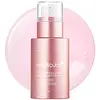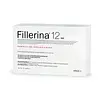What's inside
What's inside
 Key Ingredients
Key Ingredients

 Benefits
Benefits

 Concerns
Concerns

 Ingredients Side-by-side
Ingredients Side-by-side

Water
Skin ConditioningButylene Glycol
HumectantDipropylene Glycol
HumectantGlycerin
HumectantNiacinamide
SmoothingSodium Polyacrylate
Absorbent1,2-Hexanediol
Skin ConditioningCaprylyl Glycol
EmollientCetearyl Olivate
Phenyl Trimethicone
Skin ConditioningSorbitan Olivate
EmulsifyingHydrolyzed Sponge
Skin ConditioningGlyceryl Acrylate/Acrylic Acid Copolymer
HumectantEthylhexylglycerin
Skin ConditioningCalcium Aluminum Borosilicate
Adenosine
Skin ConditioningDisodium EDTA
Pvm/Ma Copolymer
Emulsion StabilisingPanthenol
Skin ConditioningLactobacillus Extracellular Vesicles
Cyanocobalamin
Skin ConditioningSodium Dna
Skin ConditioningMilk Exosomes
EmollientCollagen Extract
Skin ConditioningMacadamia Ternifolia Seed Oil
EmollientCaprylic/Capric Triglyceride
MaskingAlcohol
AntimicrobialHydrogenated Lecithin
EmulsifyingPolysorbate 20
EmulsifyingRetinol
Skin ConditioningChondrus Crispus Extract
Skin ConditioningCholesterol
EmollientSodium Hyaluronate
HumectantBrassica Campestris Sterols
EmollientPolyglyceryl-10 Laurate
Skin ConditioningCeteth-3
EmulsifyingCeteth-5
EmulsifyingTocopheryl Acetate
AntioxidantHydrolyzed Elastin
EmollientPotassium Cetyl Phosphate
EmulsifyingHydroxypropyltrimonium Hyaluronate
Acetyl Tetrapeptide-5
HumectantPalmitoyl Pentapeptide-4
Skin ConditioningSodium Acetylated Hyaluronate
HumectantHydrolyzed Hyaluronic Acid
HumectantPalmitoyl Tripeptide-5
Skin ConditioningHyaluronic Acid
HumectantSodium Hyaluronate Crosspolymer
HumectantHydrolyzed Sodium Hyaluronate
Skin ConditioningPotassium Hyaluronate
Skin ConditioningWater, Butylene Glycol, Dipropylene Glycol, Glycerin, Niacinamide, Sodium Polyacrylate, 1,2-Hexanediol, Caprylyl Glycol, Cetearyl Olivate, Phenyl Trimethicone, Sorbitan Olivate, Hydrolyzed Sponge, Glyceryl Acrylate/Acrylic Acid Copolymer, Ethylhexylglycerin, Calcium Aluminum Borosilicate, Adenosine, Disodium EDTA, Pvm/Ma Copolymer, Panthenol, Lactobacillus Extracellular Vesicles, Cyanocobalamin, Sodium Dna, Milk Exosomes, Collagen Extract, Macadamia Ternifolia Seed Oil, Caprylic/Capric Triglyceride, Alcohol, Hydrogenated Lecithin, Polysorbate 20, Retinol, Chondrus Crispus Extract, Cholesterol, Sodium Hyaluronate, Brassica Campestris Sterols, Polyglyceryl-10 Laurate, Ceteth-3, Ceteth-5, Tocopheryl Acetate, Hydrolyzed Elastin, Potassium Cetyl Phosphate, Hydroxypropyltrimonium Hyaluronate, Acetyl Tetrapeptide-5, Palmitoyl Pentapeptide-4, Sodium Acetylated Hyaluronate, Hydrolyzed Hyaluronic Acid, Palmitoyl Tripeptide-5, Hyaluronic Acid, Sodium Hyaluronate Crosspolymer, Hydrolyzed Sodium Hyaluronate, Potassium Hyaluronate
Glycerin
HumectantHydrolyzed Glycosaminoglycans
HumectantSodium Hyaluronate
HumectantCaprylyl Glycol
EmollientCarbomer
Emulsion Stabilising1,2-Hexanediol
Skin ConditioningPentylene Glycol
Skin ConditioningHydrolyzed Elastin
EmollientButylene Glycol
HumectantSodium Hyaluronate Crosspolymer
HumectantHydrolyzed Hyaluronic Acid
HumectantHydrolyzed Collagen
EmollientHyaluronic Acid
HumectantTropolone
Skin ConditioningHydroxypropyl Cyclodextrin
MaskingPhenoxyethanol
PreservativeHydrolyzed Sodium Hyaluronate
Skin ConditioningDecylene Glycol
Skin ConditioningXanthan Gum
EmulsifyingLeuconostoc/Radish Root Ferment Filtrate
AntimicrobialSodium Chondroitin Sulfate
Skin ConditioningSoluble Collagen
HumectantPalmitoyl Tripeptide-38
Skin ConditioningPhenylpropanol
MaskingPalmitoyl Hexapeptide-52
Skin ConditioningAcetyl Hexapeptide-37
Skin ConditioningPalmitoyl Heptapeptide-18
Skin ConditioningSodium Benzoate
MaskingSodium Hydroxide
BufferingEthylhexylglycerin
Skin ConditioningGlyceryl Caprylate
EmollientDisodium EDTA
Sodium Chloride
MaskingSorbic Acid
PreservativeCyclopentasiloxane
EmollientHdi/Trimethylol Hexyllactone Crosspolymer
Polysilicone-11
C30-45 Alkyl Cetearyl Dimethicone Crosspolymer
EmollientDimethicone
EmollientSteareth-2
EmulsifyingHydrogenated Lecithin
EmulsifyingXylitol
HumectantSteareth-21
CleansingLimnanthes Alba Seed Oil
Skin ConditioningBoron Nitride
AbsorbentAmmonium Acryloyldimethyltaurate/Vp Copolymer
Tocopheryl Acetate
AntioxidantStearic Acid
CleansingParfum
MaskingAllantoin
Skin ConditioningLecithin
EmollientButyrospermum Parkii Butter
Skin ConditioningSilica
AbrasivePseudoalteromonas Ferment Extract
HumectantLimonene
PerfumingLinalool
PerfumingHexyl Cinnamal
PerfumingAcetyl Hexapeptide-30
Skin ConditioningButylphenyl Methylpropional
PerfumingGeraniol
PerfumingCitronellol
PerfumingCoumarin
PerfumingCitral
PerfumingArginine
MaskingDiazolidinyl Urea
PreservativeAlcohol
AntimicrobialBHT
AntioxidantGlycerin, Hydrolyzed Glycosaminoglycans, Sodium Hyaluronate, Caprylyl Glycol, Carbomer, 1,2-Hexanediol, Pentylene Glycol, Hydrolyzed Elastin, Butylene Glycol, Sodium Hyaluronate Crosspolymer, Hydrolyzed Hyaluronic Acid, Hydrolyzed Collagen, Hyaluronic Acid, Tropolone, Hydroxypropyl Cyclodextrin, Phenoxyethanol, Hydrolyzed Sodium Hyaluronate, Decylene Glycol, Xanthan Gum, Leuconostoc/Radish Root Ferment Filtrate, Sodium Chondroitin Sulfate, Soluble Collagen, Palmitoyl Tripeptide-38, Phenylpropanol, Palmitoyl Hexapeptide-52, Acetyl Hexapeptide-37, Palmitoyl Heptapeptide-18, Sodium Benzoate, Sodium Hydroxide, Ethylhexylglycerin, Glyceryl Caprylate, Disodium EDTA, Sodium Chloride, Sorbic Acid, Cyclopentasiloxane, Hdi/Trimethylol Hexyllactone Crosspolymer, Polysilicone-11, C30-45 Alkyl Cetearyl Dimethicone Crosspolymer, Dimethicone, Steareth-2, Hydrogenated Lecithin, Xylitol, Steareth-21, Limnanthes Alba Seed Oil, Boron Nitride, Ammonium Acryloyldimethyltaurate/Vp Copolymer, Tocopheryl Acetate, Stearic Acid, Parfum, Allantoin, Lecithin, Butyrospermum Parkii Butter, Silica, Pseudoalteromonas Ferment Extract, Limonene, Linalool, Hexyl Cinnamal, Acetyl Hexapeptide-30, Butylphenyl Methylpropional, Geraniol, Citronellol, Coumarin, Citral, Arginine, Diazolidinyl Urea, Alcohol, BHT
 Reviews
Reviews

Ingredients Explained
These ingredients are found in both products.
Ingredients higher up in an ingredient list are typically present in a larger amount.
1,2-Hexanediol is a synthetic liquid and another multi-functional powerhouse.
It is a:
- Humectant, drawing moisture into the skin
- Emollient, helping to soften skin
- Solvent, dispersing and stabilizing formulas
- Preservative booster, enhancing the antimicrobial activity of other preservatives
Alcohol comes in many different forms. Different types of alcohol will have different effects on skin. This ingredient is usually an astringent alcohol.
These alcohols are drying on the skin. They may strip away your skin's natural oils and even damage your skin barrier. Astringent alcohols may also irritate skin.
Other types of astringent alcohols include:
According to the National Rosacea Society based in the US, you should be mindful of products with these alcohols in the top half of ingredients.
Any type of sanitizing product will have high amounts of alcohol to help kill bacteria and viruses.
Fatty alcohols come from plant oils such as coconut oil. These can help hydrate the skin and are non-irritating. Some fatty alcohols include cetyl and stearyl alcohol.
Learn more about AlcoholButylene Glycol (or BG) is used within cosmetic products for a few different reasons:
Overall, Butylene Glycol is a safe and well-rounded ingredient that works well with other ingredients.
Though this ingredient works well with most skin types, some people with sensitive skin may experience a reaction such as allergic rashes, closed comedones, or itchiness.
Learn more about Butylene GlycolCaprylyl Glycol is a humectant and emollient, meaning it attracts and preserves moisture.
It is a common ingredient in many products, especially those designed to hydrate skin. The primary benefits are retaining moisture, skin softening, and promoting a healthy skin barrier.
Though Caprylyl Glycol is an alcohol derived from fatty acids, it is not the kind that can dry out skin.
This ingredient is also used as a preservative to extend the life of products. It has slight antimicrobial properties.
Learn more about Caprylyl GlycolDisodium EDTA plays a role in making products more stable by aiding other preservatives.
It is a chelating agent, meaning it neutralizes metal ions that may be found in a product.
Disodium EDTA is a salt of edetic acid and is found to be safe in cosmetic ingredients.
Learn more about Disodium EDTAEthylhexylglycerin (we can't pronounce this either) is commonly used as a preservative and skin softener. It is derived from glyceryl.
You might see Ethylhexylglycerin often paired with other preservatives such as phenoxyethanol. Ethylhexylglycerin has been found to increase the effectiveness of these other preservatives.
Glycerin is already naturally found in your skin. It helps moisturize and protect your skin.
A study from 2016 found glycerin to be more effective as a humectant than AHAs and hyaluronic acid.
As a humectant, it helps the skin stay hydrated by pulling moisture to your skin. The low molecular weight of glycerin allows it to pull moisture into the deeper layers of your skin.
Hydrated skin improves your skin barrier; Your skin barrier helps protect against irritants and bacteria.
Glycerin has also been found to have antimicrobial and antiviral properties. Due to these properties, glycerin is often used in wound and burn treatments.
In cosmetics, glycerin is usually derived from plants such as soybean or palm. However, it can also be sourced from animals, such as tallow or animal fat.
This ingredient is organic, colorless, odorless, and non-toxic.
Glycerin is the name for this ingredient in American English. British English uses Glycerol/Glycerine.
Learn more about GlycerinHyaluronic acid is naturally found in healthy skin. It is a humectant, meaning it draws moisture to your skin.
This ingredient helps hydrate, soothe, and protect the skin.
What makes hyaluronic acid so hydrating? It has the capacity to bind or hold large amounts of water.
Fun fact: It is already naturally found in our bodies, such as the fluids of our eyes and our joints.
Studies find this ingredient to have anti-inflammatory and anti-microbial properties. This can help speed up wound-healing.
Hyaluronic acid can be irritating if the molecule has a low-molecular weight, or if the molecules are small.
One study found low-molecular weight hyaluronic acid to be pro-inflammatory, meaning some people may experience irritation. This is because our bodies use hyaluronic acid in the wound-healing process to signal to our bodies, via irritation, that something needs healing.
The same study found high-molecular weight hyaluronic acid to be anti-inflammatory.
These are some other common types of Hyaluronic Acid:
Learn more about Hyaluronic AcidHydrogenated Lecithin is created from the hydrogenation of lecithin (a group of phospholipids). Hydrogenation is a chemical reaction between hydrogen and another element.
This ingredient is an emollient and emulsifier. As an emollient, it helps soften skin by trapping moisture within. As an emulsifier, it prevents oil and water ingredients from separating.
We don't have a description for Hydrolyzed Elastin yet.
Hydrolyzed Hyaluronic Acid is a form of hyaluronic acid. It is created by the hydrolysis of hyaluronic acid with a high molecular weight. Once created, Hydrolyzed Hyaluronic Acid has a low molecular weight.
Low molecular weight HA has been shown to hydrate and increase elasticity of the skin. Increasing elasticity is also associated with reduction of wrinkle depth.
One study found topical low molecular weight hyaluronic acid may be considered for the treatment of rosacea in the adult population. However, we always recommend speaking with a professional about your skin concerns.
Hyaluronic acids are a humectant. This means they draw moisture from the air. Hyaluronic acids help moisturize, soothe, and protect the skin.
Read more about other common forms of hyaluronic acid:
Learn more about Hydrolyzed Hyaluronic AcidThis ingredient is created by putting sodium hyaluronate through hydrolysis.
You might know this as 'mini' or 'ultra low-molecular weight' hyaluronic acid. The small molecule size means it is able to travel deeper in the skin.
According to studies, low molecular-weight hyaluronic acid can:
One study from 2011 found ultra-low weight HA to show pro-inflammatory properties. Another study from 2022 found it to downregulate UV-B induced inflammation.
Hydrolysis is a process of changing a molecule using water or enzymes.
This ingredient is water-soluble.
Learn more about Hydrolyzed Sodium HyaluronateSodium Hyaluronate is hyaluronic acid's salt form. It is commonly derived from the sodium salt of hyaluronic acid.
Like hyaluronic acid, it is great at holding water and acts as a humectant. This makes it a great skin hydrating ingredient.
Sodium Hyaluronate is naturally occurring in our bodies and is mostly found in eye fluid and joints.
These are some other common types of Hyaluronic Acid:
Learn more about Sodium HyaluronateSodium Hyaluronate Crosspolymer is a type of hyaluronic acid. In fact, it is modified version of hyaluronic acid.
The structure of Sodium Hyaluronate Crosspolymer allows it to stay in the skin's top layer for a longer period of time. This allows for even more hydration and humectant action than hyaluronic acid.
These are some other common types of Hyaluronic Acid:
Learn more about Sodium Hyaluronate CrosspolymerTocopheryl Acetate is AKA Vitamin E. It is an antioxidant and protects your skin from free radicals. Free radicals damage the skin by breaking down collagen.
One study found using Tocopheryl Acetate with Vitamin C decreased the number of sunburned cells.
Tocopheryl Acetate is commonly found in both skincare and dietary supplements.
Learn more about Tocopheryl Acetate